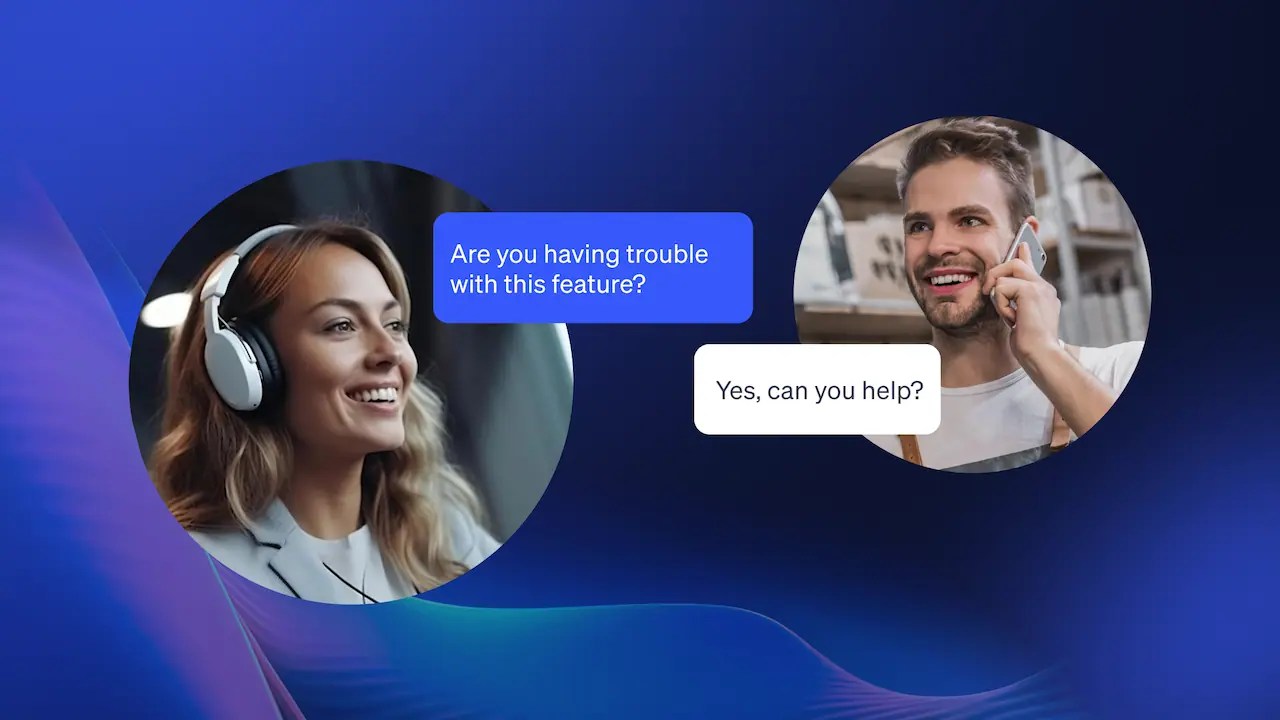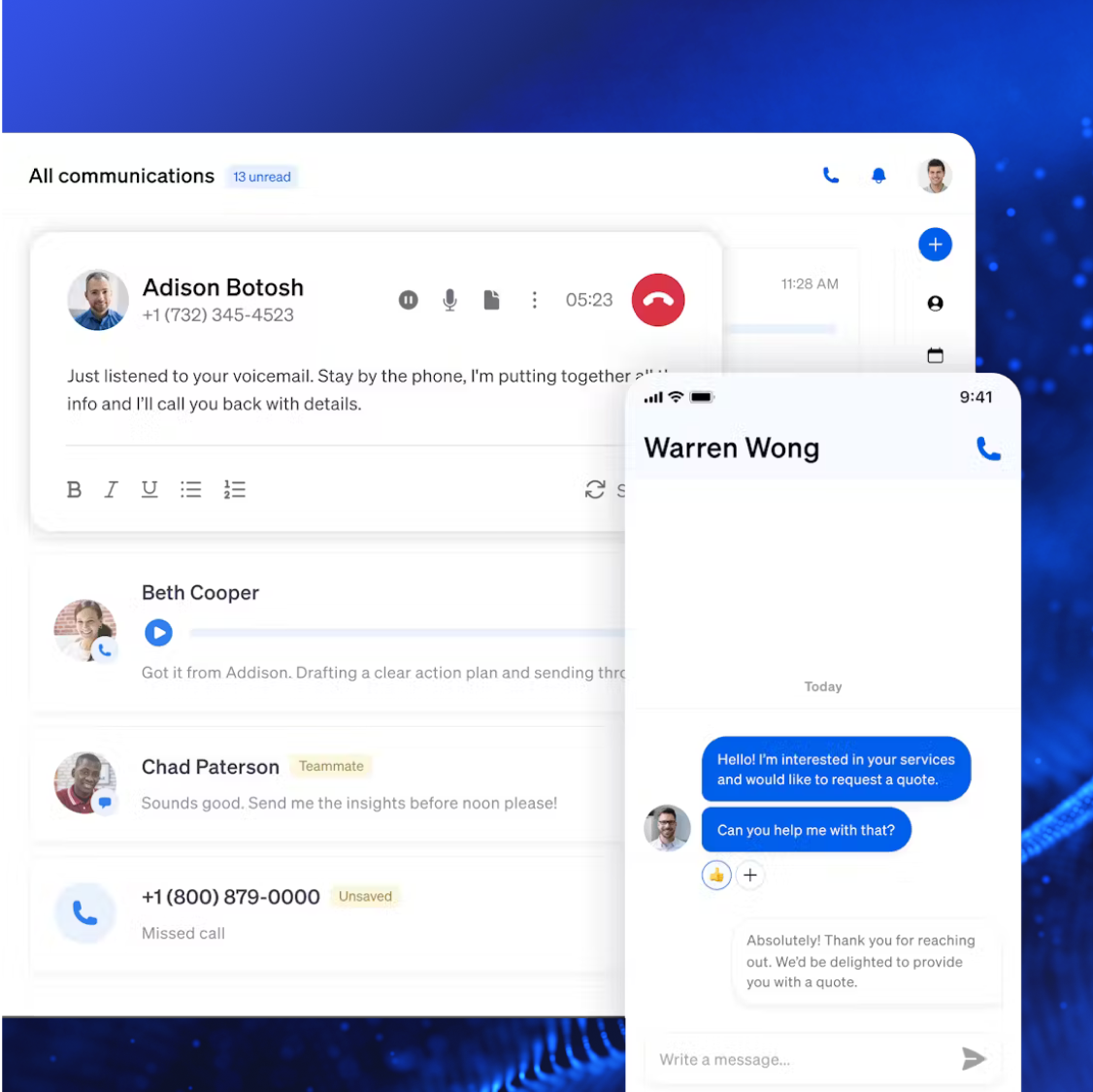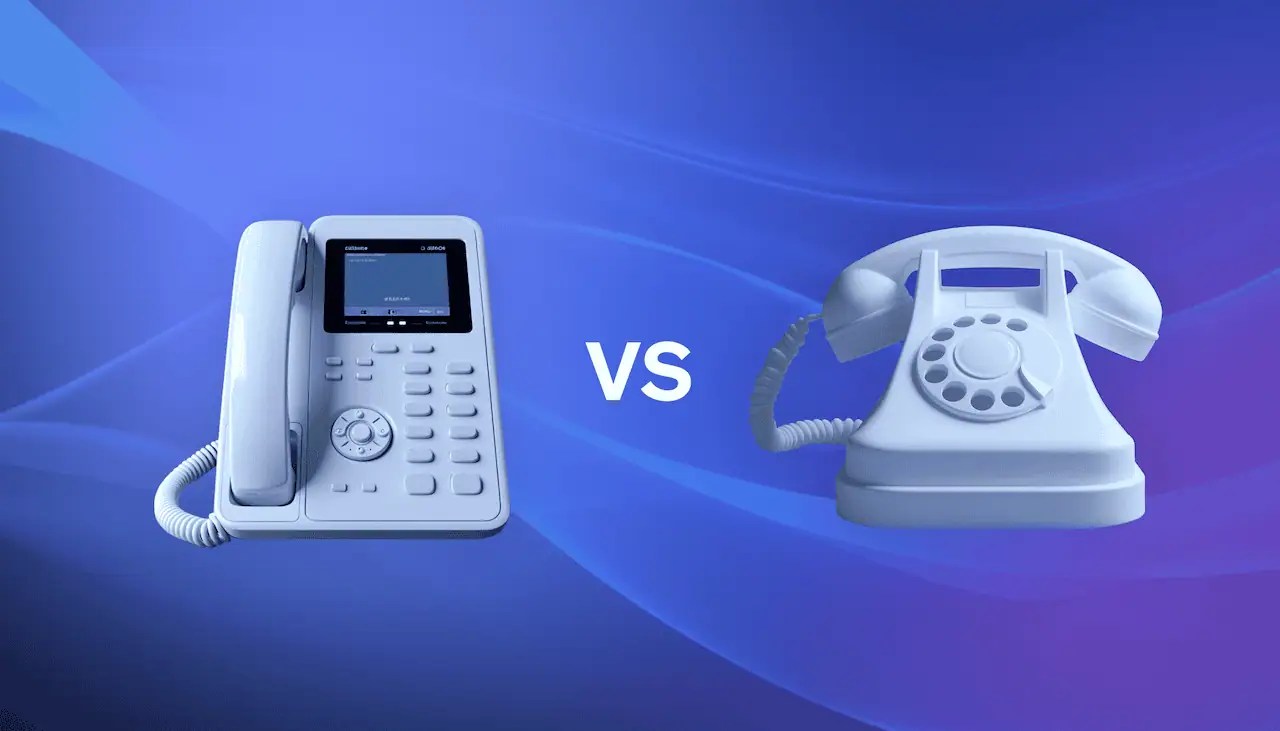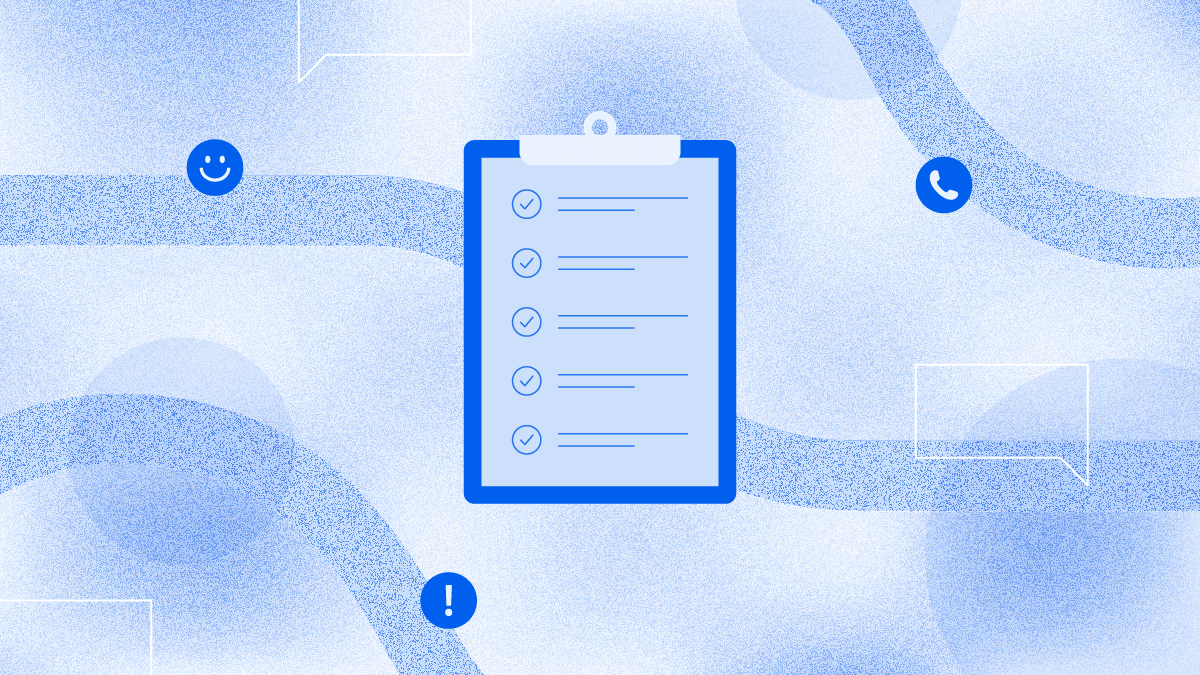What exactly is contact center infrastructure software? Any given contact center consists of several moving parts, from the many communication channels to the data and analytics that guide the decision-making process. Each element must work properly for an efficient, effective contact center environment to prosper.
With that in mind, let’s break down the inner workings of a contact center, including the different channels, analytics, and infrastructure for both agents and admins.
Customer Interaction Channels
The first thing to consider is the channels you’ll use to interact with customers. A good omnichannel contact center can support customer interactions across whichever communications channel the customer prefers, including:
Voice communication
Voice communication over the telephone or digital lines is perhaps the most important channel for customer interactions. Of course, voice communication is more than just setting up a phone and letting customers call in. Voice communication consists of:
- Automatic call distribution, which routes inbound calls to the appropriate agent or department based on preset rules. The call routing can be based on factors such as agent skills, earliest availability, a set turn order, and many other configurations.
- Interactive voice response (IVR), which uses voice menus to automate tasks such as answering basic customer inquiries, routing calls, and checking balances. If you’ve ever called a business number and had a prerecorded voice say “For customer support, press 1…,” then you’ve experienced an IVR menu.
- Voice over IP, which allows organizations to handle voice calls over the internet. This reduces the need for traditional phone lines and integrates easily with digital systems, which makes it easier to connect phone systems to tools like customer relationship management (CRM) systems and AI-powered support tools.
- Call recording and transcription features, which record and transcribe calls for compliance, training, and performance analysis. Call transcriptions provide searchable records, and the transcripts can be used with tools that search conversation data for actionable information, like sentiment analysis and trend analytics.

Email management
Email is an essential channel for customer support. While it’s not necessarily as fast as phone calls, it allows customers to reach out to support at any time of the day and receive clear, written instructions in return. Email management typically includes:
- Email routing and automation, which automate incoming email distribution. This directs emails to agents based on factors such as keywords within the email, subject matter, or any prior interactions the customer has had with agents.
- Email templates, which provide preconfigured responses for common inquiries. This allows agents to respond to basic emails quickly and provide a consistent experience across the contact center, improving the speed and efficiency of email responses.
Live chat
Live chat allows customers to communicate with agents over text chat in real time, typically through built-in chat boxes. This is a fast, convenient option for users who need a live agent but can’t or would prefer not to speak on the phone. It also provides a clear, written record of the conversation for both the customer and agent. Live chat includes:
- Live chat platform, which enables real-time, text-based communication via the company website or app.
- Chatbots, which can handle initial queries or simple tasks. While the most basic versions use simple menus with limited options, many have begun using generative AI to provide responses tailored to the customer’s prompts. Chatbots can also escalate conversations to live agents when necessary.
- Co-browsing, which allows agents to view and interact with a customer’s web page. This means agents can provide direct assistance in real time, as they can see exactly what the customer sees and does.

Social media integration
Social media has become a popular channel for customers to interact with brands, whether by reaching out to the company directly or simply by mentioning them in their posts. Organizations can use social media integrations to connect with these customers through tools like:
- Social listening tools, which track and analyze customer mentions and brand sentiment across various social networks. This helps organizations understand how customers feel and what they’re saying about a brand across networks like Facebook, Instagram, LinkedIn, and X (formerly Twitter).
- Omnichannel social response, which enables agents to manage social media interactions alongside traditional channels. This means that when a customer messages a brand’s social accounts, agents can see the message and reply, ensuring fast and consistent responses across channels.

Video support
Sometimes, the best way to support a customer is through face-to-face interactions. Video support provides that personal connection, allowing agents to see customers and guide them directly, thus creating a more engaging and effective support experience.
There are different types of video support: one-way video allows the agent to share their video feed while the customer remains off-camera, whereas two-way video enables both the agent and the customer to be on camera, fostering a more interactive and personal experience.
Visual cues improve communication by eliminating potential misunderstandings, which ensures that the agent and customer are on the same page. Overall, the personalized and efficient nature of video support leads to faster resolutions and a more engaging customer experience, helping businesses foster stronger relationships with their customers.

Here are some use cases for video support:
- Product demos, which enable agents to walk customers through complex products or services, highlighting new features and answering questions in real time.
- Technical troubleshooting, which lets customers show the issue they’re experiencing, allowing agents to diagnose and resolve problems faster.
- Onboarding and training, which enable agents to meet with new customers on video calls to provide a more engaging way to guide them through the initial setup process.
Data Collection and Sentiment Analysis
If you want to get the greatest value out of your calls, you need to be able to gather and analyze the data. Each conversation is a treasure trove of customer knowledge, but without the right tools, those valuable insights will remain out of reach.

These tools include:
Speech analytics
Speech analytics tools are designed to analyze call recordings and gather key information from them. This can be used to identify keywords and important phrases and assess customer behavior and sentiment, which are important for helping your contact center and business grow.
Text analytics
Not every conversation is spoken. Text analytics tools are just as important as speech analytics, as they can analyze written communications across channels such as email, chat, and social media. The analytics tools can identify customer sentiment, trends based on keywords, and even emotional cues in those conversations.
Sentiment analysis tools
Contact center agents aren’t mind readers, but with the right technology, they might as well be. Sentiment analysis tools use AI to gauge customer emotions during interactions and then provide real-time feedback so agents can adjust and ensure calls are successful and customers are satisfied.
Managers can also look back over the sentiment analysis historical data to identify customer pain points, areas for growth, or good examples to use for agent training.

Customer surveys
Often, the best way to know how a customer feels is to let them tell you in their own words. Post-interaction surveys can be used to gather feedback from real customers, measure satisfaction and loyalty, and identify areas for improvement.
Agent Infrastructure
A contact center is nothing without agents to keep it staffed and running, so agents must have the tools and infrastructure they need to be productive and efficient. What do they have in front of them every day, what tools do they use, and how can supervisors help them grow?
What your agents are seeing
It’s time to see things from a contact center agent’s point of view. When an agent sits down at their desk, they’re likely to have these in front of them:
- Omnichannel dashboard, which presents a single interface that consolidates all communication channels, including voice, email, chat, and social media. This keeps everything the agent needs within reach and in a single pane of glass so they can monitor their channels and quickly assist customers without switching platforms.
- A knowledge base that provides quick access to everything the agent needs to know. This often includes company policies, frequently asked questions, and troubleshooting guides to assist agents and resolve issues quickly and effectively.
- Customer interaction history,which displays a complete record of past customer interactions across all channels. This allows agents to personalize their service, as they can see what issues a customer has had, what solutions were used, and any other pertinent information about each customer.
What your agents use for productivity
How can you help your agents be their most productive? There are several agent productivity tools available that can help agents access the information they need when they need it and automate time-consuming tasks. These include:
- Call scripting, which provides agents with real-time scripts and workflows based on customer interaction data. These go beyond simple scripts agents need to read from, as they adapt to the conversation and customer’s needs. For example, if a sentiment analysis tool detects frustration, the script might shift to a more empathetic tone and suggest escalating the issue to a supervisor. This dynamic approach ensures agents are always aligned with the customer’s emotional state, improving outcomes.
- Automatic screen pop, which automatically presents agents with relevant customer information when a call or chat begins. This includes past interaction information, products owned, and other pertinent information so the agent can provide a personalized experience.
- Workflow automation, which automatically carries out repetitive, mundane tasks, such as logging interactions and sending follow-up emails. Automation tools save agents time on every call, reducing their workload and giving them more time to dedicate to customers.
- Collaboration tools, which enable communication and real-time collaboration between agents and supervisors. For example, should an agent need to escalate a complex issue or check in with a supervisor before making any agreements, they can connect without difficulty or delay.

What supervisors use to monitor agent performance
While no one likes having their boss hover over their shoulder, performance monitoring is still important for contact centers. There are tools and solutions that can monitor and improve agent performance without being invasive, including:
- Real-time monitoring tools that track real-time agent activity such as call status, time on call, and customer waiting times. These provide supervisors with an overview of the contact center and agent activity so they can pay close attention to any specific calls or agents if needed. For example, a supervisor might notice that an agent has been on a lengthy call, causing customer wait times to increase. This, in turn, prompts the supervisor to reassign incoming calls to other agents to balance the workload and reduce delays.
- Gamification tools that use performance metrics to engage agents through challenges, rewards, and scoreboards. These help encourage productivity and introduce friendly competition, incentivizing agents to improve while tracking their performances.
Supervisor Infrastructure
Contact center supervisors also require specific tools and infrastructure to keep contact centers running smoothly and support their agents. These tools provide not only an overview of the contact center environment but also the ability to assist and guide agents to ensure they can keep delighting customers.
Monitoring and quality assurance
One of the most important tasks contact center supervisors have is monitoring their agents and maintaining a high level of quality across the contact center. Monitoring and quality assurance (QA) tools empower supervisors to help agents provide high-quality support and include features such as:
- Call barging and whispering, which allow supervisors to monitor calls silently and step in to assist as needed. If agents need a gentle nudge, supervisors can use call whispering to guide the agent without the customer hearing, but if more direct intervention is required, they can use call barging to enter the call and assist the customer directly.
- Quality monitoring tools, which review recorded calls and chat transcripts. These are essential for assuring quality, monitoring customer satisfaction, and ensuring agents comply with company protocols.
- Analytics and reporting, which provide detailed performance reports. These reports typically include analyses of agent performance, customer satisfaction scores, channel usage, and any other trends that will be useful for agent training and guidance.

Workforce management
While monitoring and assisting individual agents is important, supervisors must consider the entire workforce. Workforce management solutions help supervisors ensure their contact centers are fully staffed, agents are scheduled properly, and work is moving smoothly thanks to a variety of powerful features, including:
- Scheduling and forecasting tools,which analyze historical data to help supervisors forecast call volumes and schedule agents accordingly. This helps prevent both overstaffing and understaffing, as it ensures supervisors know how many agents they’ll need on any given day, including seasonal events and changing trends.
- Agent availability monitoring, which tracks agent availability and performance in real time. This helps ensure the contact center operates efficiently, as supervisors can step in and help any agent who’s struggling or fill in for unavailable agents.
- Task automation, which saves time and improves efficiency by automating shift scheduling, adherence tracking, and alerts for break violations or performance gaps.
Administrator Infrastructure
System administrators also have specific infrastructure needs. The right tools and solutions can help them maintain, support, and protect the contact center technology and data, ensuring smooth operations.
System management
One of the most important tasks for administrators is system management. High-quality solutions give them a powerful, user-friendly means of monitoring and managing the contact center, including:
- Configuration management, which provides centralized control over all contact center settings. This includes user roles, permissions, workflows, and routing logic so admins can easily customize the contact center according to the business needs.
- User management and permissions,which allow administrators to manage agent roles, permissions, and access to various tools and customer information. These features help ensure agents who need access to certain information can easily access it, while those without permission are kept safely away.

CRM and third-party integrations
No single solution can do everything — sometimes you need to integrate your solution with a third-party tool or connect multiple platforms. These include:
- CRM integrations, which connect contact center solutions to CRM platforms like Salesforce, HubSpot, and Zoho. This allows users to manage customer data, synchronize data across platforms, and automatically log calls and customer interactions. As a result, agents can work more efficiently and keep customer information organized in one place.
- Business process integrations, which connect the contact center to enterprise tools such as enterprise resource planning platforms, ticketing systems, and e-commerce platforms. This creates a more seamless customer experience, streamlining business processes and the customer journey.
Security and compliance
Security is of the utmost importance for any organization, especially one that handles customers’ personal or financial data. Additionally, many industries (such as healthcare or finance) have strict security standards that contact centers must comply with. As such, it’s essential to keep the following security features in mind:
- Data encryption and privacy compliance, which ensure that customer data is encrypted, secure, and stored in a way that’s compliant with all relevant regulations. This can include GDPR, CCPA, HIPAA, or any other security standards — it’s vital to know what’s required for your industry.
- Fraud detection, which uses algorithms and analysis to detect unusual patterns in transactions that might indicate fraudulent activity. Once the tool detects suspicious behavior, it notifies the relevant users so they can investigate further and stop potential fraud before it becomes an issue.
Disaster recovery and scalability
Businesses with contact centers tend to have two major concerns: what do I do if something goes wrong, and how can my contact center grow with my business? For the former, we have disaster recovery, and for the latter, there’s scalability.
Having cloud infrastructureis an excellent way to address both concerns. Cloud contact centers offer built-in redundancy, ensuring business continuity even during a disruptive event. This includes data backups, multiple servers, and even secondary locations so an interruption anywhere won’t be more than a minor inconvenience.
Additionally, cloud-based contact center infrastructure can rapidly scale. Should an organization need to add more seats, it can simply purchase another license and set up the account. Contact centers can add or reduce agents to meet changing demand, such as during seasonal surges, so they never pay for seats they don’t need.

Reporting and Analytics
Managers and supervisors need to understand how their contact centers and agents are performing. This makes reporting and analytics features essential for any contact center environment, as they provide actionable insights across the contact center.
Operational reporting
Operational reporting provides data and insights into the daily contact center operations of both agents and channels. This includes:
- Agent performance reports, which provide detailed metrics on agent KPIs. These can include average handle time, first call resolution, and customer satisfaction scores.
- Channel performance reports, which provide detailed performance data on each communication channel, including calls, chats, and emails. This allows organizations to optimize their resource allocation and ensure they’re meeting customers where they are.

Customer experience reporting
How can you ensure customers are satisfied? Customer experience reporting provides insights into the customer journey and customer satisfaction with features such as:
- Customer journey mapping, which provides a visual map of the customer journey across channels. This helps identify bottlenecks and opportunities for improvement as well as shows what channels customers are using and how.
- Customer satisfaction metrics, which aggregate data from customer surveys, sentiment analysis, and interaction history to provide insights into the customer experience and any trends of note.
The Role of AI Across Contact Center Operations
AI in contact centers is revolutionizing every aspect of operations by enhancing efficiency and improving customer experiences. Here’s how AI impacts the key infrastructure areas of your contact center:
- Customer interaction channels: From AI-powered IVR to chatbots and social listening tools, AI enhances communication across voice, email, live chat, social media, and video support, ensuring faster, more accurate, and more personalized interactions.
- Data collection and sentiment analysis: AI tools collect and analyze vast amounts of data across all channels, providing actionable insights into customer behavior, sentiment trends, and areas for operational improvement.
- Team infrastructure: AI enhances agent productivity tools, such as call scripting and workflow automation, by dynamically adapting to live customer data and sentiment, ensuring a personalized and efficient customer experience. AI-driven monitoring tools flag issues in real time, helping supervisors focus on critical interactions and streamline QA processes.
- Reporting and analytics: AI-driven analytics tools provide real-time dashboards and predictive insights, allowing businesses to forecast trends, identify performance gaps, and optimize resource allocation. These insights enable teams to make data-driven decisions quickly, improving overall operational efficiency and customer satisfaction.
By embedding AI into these functions, contact centers can streamline operations, enhance agent performance, and deliver highly personalized customer experiences.
Nextiva: Everything in One Platform
Creating a successful contact center involves more than just deploying the latest tools. It requires a well-rounded approach that integrates communication channels, data-driven insights, and robust agent support systems. When all these elements work together, businesses can deliver exceptional, personalized customer experiences while driving operational efficiency.
A well-designed contact center not only improves customer satisfaction but also empowers agents to perform at their best, ensuring faster resolutions and building long-term customer loyalty. The right mix of technology and strategy can transform your contact center into a true competitive advantage for your business.
That’s where Nextiva comes in. With its comprehensive, scalable platform, Nextiva equips businesses with everything they need to manage a high-performing contact center, from omnichannel communication to advanced analytics and seamless integrations, including:
- Omnichannel communications
- Workforce management
- Advanced call analytics
- Automatic call transcriptions and summaries
- Real-time dashboards and reporting
- Full API access
- And so much more
Additionally, Nextiva’s contact center infrastructure software is easy to use and is designed to integrate easily with existing contact center environments. So if you’re looking to empower your agents, delight your customers, and create a fantastic omnichannel contact center, Nextiva is the way to go.
Wow customers every day. Learn more about Nextiva. 👇
Call Center Solutions
Nextiva makes it easy to take more customer calls with fewer agents. Run your call center in the cloud today.















 VoIP
VoIP 









